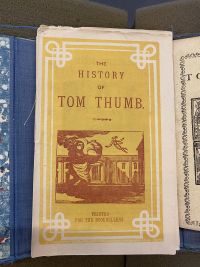The History of Tom Thumb
Introduction
Checking out The history of Tom Thumb found in the University of Pennsylvania’s Kislak Center for Special Collections, Rare Books, and Manuscripts, not only is one presented with the classic British fairytale, but rather, they are presented with a large collection of early children’s literature dating all the way back to the early 19th century. Upon giving one’s name at Kislak, the staff will not deliver the type of simple little picture book that one flips through as a child, but rather, they will present a codex-appearing box with a weathered and embellished spine that reads “History of Tom Thumb” and “Dialogue Between Two Country Lovers” in gold.
Containing 22 early reader chapter books and toy books, The history of Tom Thumb goes beyond the three-part story and contains a variety of early picture books that demonstrate children’s literature of the 19th century. Each of them is no more than 24 pages and have the ability to fit in the palm of one’s hand, demonstrating how both their content and physical material were designed for their audience: children.
History
Toy books
During the 19th century, publishers of children’s picture books became known as “toy books” for their nature of being sold alongside candy and stationary sets in general stores as according to book historian at the Kislak center, John Pollack. Because while chapter and pictures books were utilized to encourage early childhood education and reading, for both book historians and child readers themselves, the picture book served an important role in as an object itself. According to English and children’s literature professor at Indiana University Northwest, George Bodmer, he describes the physical properties of the toy book as the following:
“It's something to be held, sniffed, tasted, and enjoyed. It's a toy, an object to bring amusement. In the case of pop-up books, or shaped or textured books, for instance, this objective nature is literally true. It's hardware.”
Additionally, the Britain dominated the realm of children’s literature, demonstrating the presence of London being listed as the publication city for many of the toy books. The series of 16 toy books were also published directly from Otley Publishing Company, a publishing and stationary company that operated in Hanover Square from 1826-1834. This influence of the toy book soon spread to America as one of the books featured in the Tom Thumb collection, Divine and Moral Songs for the Use of Children, was published in New York City and followed similar toy book publishing practices in terms of paper material, size, and imaging.
The Story of Tom Thumb
The story of Tom Thumb is a classic example of British folklore, an authorless story that continues to be told for centuries and printed in a variety of ways. Captured in three parts, the story highlights a little boy by the titular name who gets into adventures and mischief, whether it’s meeting King Arthur and the Knights of the Round Table or accidentally being swallowed by a cow.

Though the story of Tom Thumb remains author-less, it became one of the first fairy tale published in English and its first copy can be dated all the way to 1621. This lack of authorship also allowed for freedom of creative expression since there was no author copyright, which explains the different styles of publishing for the story of Tom Thumb. While the traditional story of Tom Thumb is published in three parts and can be seen through the three separate toy books, Otley publishing company produced a completely different style of story, utilizing colored images as well as compiling all three parts into one condensed. In the true nature of folklore, Tom Thumb represents how one story can be interpreted in multiple different ways, both in terms of content and form.
Material Analysis
The Book Container
To contain all the various toy books, a container was constructed to house them all. When arriving to the Kislak Center, those who request The history of Tom Thumb are given a book cloth covered book with a leather spine that read “History of Tom Thumb” and “Dialogue Between Two Country Lovers” in gold embellished text. The container highly resembles a traditional codex in appearance and feel, but while the box itself looked like a book, it was not one itself as it lacked bound pages or real content. Rather, the initial container resembles a cardboard binder in a light blue book cloth and is tied together with a matching-colored ribbon. As noted by John Pollack, book cloth was highly utilized in the 19th century as it was invented during the 1820s. Both the leather and cardboard showed signs of temporal wear and tear, which can be justified by the Kislak Center citing the works being published sometime around 1840. This choice for a book cloth covered codex-like container also can be attributed to the nature of the toy books themselves since they are all extremely fragile and allowed for easy transport of children; it is symbolic of a children’s toy chest.
Early Chapter and Toy Book Binding
Paper Material
Content
The History of Tom Thumb
Earl of Warwick
Otley Chapter Toy Books
Divine and Moral Songs
Significance
References
Bodmer, George R. "Workbooks and Toybooks: The Task and the Gift of a Child's Book." Children's Literature Association Quarterly 24, no. 3 (1999): 136-40.
Bold, Melanie Ramdarshan. "Leading the Way: Women-Led Small Presses of Inclusive Youth Literature." In The Contemporary Small Press, edited by Georgina Colby, Kaja Marczewska, and Leigh Wilson, 173-97. London: Springer Nature, 2020.
Field, Hannah. Playing with the Book: Victorian Movable Picture Books and the Child Reader. Minneapolis: University of Minnesota Press, 2019.
Paul, Lissa. The Children's Book Business : Lessons from the Long Eighteenth Century. London: Taylor & Francis Group, 2011.